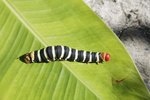
A ladybug in the wild can live up to two to three years, the National Geographic website reports. Ladybugs have a long history as beneficial insects and are even available for purchase to control pests in gardens, landscapes and farms. The ladybug evolved several adaptations to help it survive in its environment and give her offspring the best chance of a long life.
Background
Ladybugs, members of the family Coccinellidae, aren't just any kind of bug. They're beetles, and there are about 5,000 species of them. The name ladybug or ladybird dates from the Middle Ages. A popular legend says people in Europe prayed to the Virgin Mary and ladybugs saved them from starving by eating crop-destroying aphids, according to the Cornell University Lab of Ornithology Lost Ladybug Project. Most species of ladybugs can eat an enormous number of such plant-destroying pests. They start eating insects in their larval stage and continue throughout their lives. Ladybugs have several defensive strategies to improve their chances of living long enough to reproduce.
Appearance
Ladybugs have a round or lozenge shape with a high back and flat abdomen. They have small legs and antennae. They have a hard outer shell known as the elytra that helps to protect them from predators. When you see a closeup photo or get near a ladybird as it takes off in flight, you can sometimes see the transparent wings, similar to a fly's, that are protected by the outer red casing on her back. Unlike insects that blend in to their environment to reduce the risk of being eaten, a ladybug's bright color and memorable polka dots warn predators away.
Secretions
These seemingly defenseless beetles developed a powerful deterrent for potential predators. They taste foul. Their leg joints give out a dose of strong, bad-tasting goo. Any insect or animal that eats one of these awful beetles will remember the warning red color and spots, making it unlikely to chow down on any more of them, the National Geographic reports. Being undesirable as a snack helps ladybugs live longer, since birds and most animals won't eat them.
Behavior
Ladybugs fly away, just as the popular children's rhyme suggests. The ability to fly gives ladybugs an advantage for fleeing from danger. When a ladybug lays her eggs, she chooses an area of her environment rich in food for her young, such as a plant covered in insects. This strategy helps ensure the survival of the young, defenseless offspring. Her larvae consume the insects to fuel their growth. This gives ladybugs a chance at a long life and helps the plants by reducing populations of harmful insects. Pesticides kill ladybugs. Maintaining a healthy, non-toxic yard and garden allows ladybugs to live out their lifespan and help keep pests from taking over.
References
Resources
Photo Credits
-
John Foxx/Stockbyte/Getty Images
Writer Bio
Gryphon Adams began publishing in 1985. He contributed to the "San Francisco Chronicle" and "Dark Voices." Adams writes about a variety of topics, including teaching, floral design, landscaping and home furnishings. Adams is a certified health educator and a massage practitioner. He received his Master of Fine Arts at San Francisco State University.



